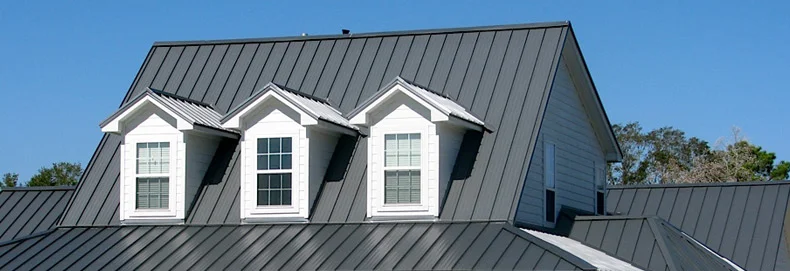
08 Nov
The Merits and Drawbacks of Metals Roofs
When a roof needs to be changed due to aging or new construction, metal roofs are frequently chosen. Galvanized steel, copper, aluminum, or tin are just a few of the metals that can be used to make metal roofing products, and they can all be installed using a variety of techniques. There are many advantages of metal roofs, but there are also a few drawbacks to take into account.
Metal Roofs and Lighting
People seem to be more worried about lightning when a metal roof is used on a project, and some people wonder if using metallic roofing makes lightning strikes more likely. This risk is not at all increased by this type of roofing.
According to all of the current evidence, a metal roof is neither more nor less probable than any other form of roofing material to be struck by lightning on any given building. The energy from a lightning strike will actually be conducted over a larger area of a properly grounded metal roof, limiting the amount of heat transported to the building and lowering the risk of fire damage.
The dangers of using a metal roof may make it a less preferable building material because it is an electrical conductor and noncombustible. It should be noted that additional lightning protection may, in some circumstances, be wise to take into account to reduce the damage caused by a lightning strike. To give the electrical charge a path of least resistance through which electrical energy can flow, a lightning protection system provides a continuous conductor from the sky to the earth (and vice versa). This lowers the risk to (electrically) resistive building materials and human life.
Some Actual Disadvantages of Metal Roofs
Knowing the metal roof cons helps you prepare for the worst problems that could arise.
1. Installation Complexity: This is one of the disadvantages of metal roofs because it calls for specialized knowledge and abilities, which may not be available to all contractors or do-it-yourself enthusiasts. This type of roofing is prone to seam failure if improperly installed. It can also result in problems like leaks, fastener failure, or insufficient ventilation, which can cost a lot of money to fix or replace.
2. Expansion and contraction: Over time, temperature variations in places like Los Angeles, San Diego, and Orange County can cause metal roofing to expand and contract, potentially causing the iron-like panels to become loose or warp. This could result in water infiltration problems that need upkeep or repairs.
3. Cost: It is more expensive than most other roofing solutions. This is the most well-known of the numerous disadvantages of metal roofs. For instance, a metal roof costs at least twice as much as an asphalt shingle roof. But keep in mind that a metal roof typically lasts far longer than an asphalt shingle roof.
4. Noise: Compared to other roofing materials, a metal roof can make greater noise from rain, hail, and other weather-related events. Any object falling on this type of roofing will be louder than an object falling on a wood shake or asphalt shingle roof; it is a basic fact. Some individuals could find this irritating, especially if the metal roof is placed directly over occupied sections without the necessary insulation. However, you must know that the advantages significantly outweigh the disadvantages of this type of roofing. For example, modern installation techniques can insulate slightly against this noise, and over time, owners of metal roofs rarely perceive this as a significant metal roof cons.
Advantages Greatly Outweigh the Drawbacks
This type of roofing continues to grow in popularity despite some potential drawbacks because the advantages of metal roofs greatly outweigh their cons. benefit when seen in the overall context. Although they are initially much more expensive than, say, an asphalt shingle roofing, it usually proves to be a better investment because of how long it lasts. Some of the numerous benefits of a metal roof are that:
1. Compared to other roofing options, they are more wind-damage resistant.
2. When this iron-like roofing has served its purpose, it can be recycled.
3. In hot areas, the surface reflects heat, cutting cooling costs.
4. Given their fire resistance, metal roofs are a wise choice in places at risk of wildfire.
5. Unlike asphalt shingle roofs, which have a lifespan of 15 to 25 years, metal roofs have a lifespan of 50 to 75 years or even more.
6. They are less prone to leaking when installed properly than shingles.
When choosing the ideal roofing material for your home, weigh both the pros and cons of the metal roof. What’s more? If your property is situated anywhere in the counties of Ventura, San Bernardino, San Gabriel, or California, you must ensure you hire a reputable roofing company, such as Specialty Roofing, to get the best benefits from your metal roofing project.

